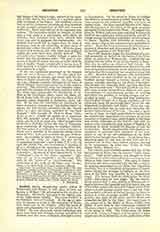

Ceolfrid, Saint, Benedictine monk, Abbot of Wearmouth and Jarrow, b. 642, place of birth not known; d. September 29, 716, at Langres on the frontier of Burgundy. His family belonged to the highest rank of the Anglo-Saxon nobility. The name Ceolfrid is the Teutonic form of Geoey. At the age of eighteen he became a monk in the monastery of Ripon, then ruled over by St. Wilfrid. After ten years of study and preparation he was ordained priest by St. Wilfrid. He soon afterwards visited Canterbury and spent some time with Botulph, founder and Abbot of Icanhoe, now the town of Boston (Botulph’s town) in Lincolnshire. On his return to Ripon he fulfilled the duties of novice-master, in which capacity he became noted for his profound humility and love of menial work. His fame reached the ears of St. Benedict Biscop, then in the midst of his great monastic enterprise on the banks of the Wear. He begged him from St. Wilfrid, and soon after reaching Wearmouth Ceolfrid was made prior of the monastery and left in charge during the absence of Benedict on his journeys to Rome. Meeting with difficulties as superior, he went back to Ripon, but was afterwards persuaded to return. From this time he became the constant companion of Benedict and accompanied him to Rome on his fifth journey to the Holy City.
About 681 Benedict began the foundation of a second monastery at Jarrow on the banks of the Tyne about six miles from Wearmouth. Ceolfrid was appointed the first abbot to act as the deputy of Benedict, who in reality was abbot of both houses. He took with him seventeen monks from Wearmouth, and from an inscription formerly on the wall of the church we learn that the monastery was completed about 684 or 685. Benedict died January 12, 690, and directed the brethren to elect Ceolfrid to be his successor. Ceolfrid proved himself a worthy disciple of his master, carefully carrying out the ideals of Benedict. His disciple, the Venerable Bede, has thus described his character and work: “This last [Ceolfrid] was himself a man of most extraordinary diligence and superior quickness of apprehension; prompt in carrying into effect but prudent in forming designs and unrivalled in piety. During this long administration Ceolfrid brought to a happy conclusion all the admirable plans for promoting piety which his distinguished predecessor had begun. Time also suggested and enabled him to carry into execution numerous improvements of his own. Amongst a great variety of these, we ought particularly to notice that he considerably augmented the number of private oratories or chapels of ease; added largely to the plate and sacred vestments of the Church, and with an ador which equalled the past energy of Benedict in founding, he nearly doubled the libraries of both his monasteries. Besides innumerable other literary acquisitions he procured three pandects of the new, added to one of the old translations of the Bible which he had brought from Rome. In his latter days, departing again for that city, he took with him as a donative one of these three valued volumes, leaving to his monasteries the other two” (Liber de Vitis Abbat. Wirim, Wilcock tr.).
This volume, which Ceolfrid carried with him on his last journey to Rome, was the famous “Codex Amiatinus“. Until recent years it was thought to have been the work of Servandus, abbot of a monastery near Alatri in Italy (sixth century). The name of Cassiodorus has also been connected with this MS., owing to its striking resemblance to his Bible; but Vigouroux concludes that it is absolutely independent of Cassiodorus, though the prologue it contains on the divisions of the Bible may possibly be of Cassiodorian origin. The famous Catholic antiquarian, De Rossi (1888), discovered its true origin. He has conclusively proved that it was written at Wearmouth or Jarrow between the years 690 and 716; that it was one of the three copies of St. Jerome’s Vulgate which Bede refers to in the passage quoted above; and that Ceolfrid carried it with him on his last journey to Rome to present it to the sovereign pontiff. He died on the journey, but some of his party reached Rome and presented the MS. to the pope. For many years it was preserved in the Abbey of Monte Amiato near Siena; it now rests in the Laurentian Library, at Florence, where it was transferred at the suppression of the abbey in 1786. This Codex gives the oldest text of St. Jerome’s Vulgate and has played a most important role in its history; in the publication of the Sixtine and Clementine editions of the Bible it was preferred to all other MSS. Samuel Berger says of it: “It is from Northumberland that the correct texts of the Vulgate were sent out not only throughout Italy, to which England was thus paying a debt, but also throughout France. Alcuin was from York and had been chosen by Charlemagne to correct the text of the Bible.” He was instrumental in extinguishing the last remnants of Celtic particularism in the celebration of Easter (q.v.).
Ceolfrid obtained from Pope Sergius I letters of immunity for his two monasteries, and had them presented before a synod of English bishops in the presence of King Alefrid, thus obtaining both royal and episcopal sanction. With the advance of years came sickness and infirmity, and he resigned his office with the intention of journeying to Rome, there to end his days. He also wished to give his brethren an opportunity of “living under the direction of a younger abbot, that the example of a more active leader might inspire them with greater ador in the pursuit of virtue”. He died on this last journey at Langres, and was buried in the church of the three martyrs, Sts. Speusippus, Eleusippus, and Meleusippus. His relics were afterwards transferred to Jarrow and thence, in the time of the Danish invasions, to Glastonbury.
G. E. HIND

